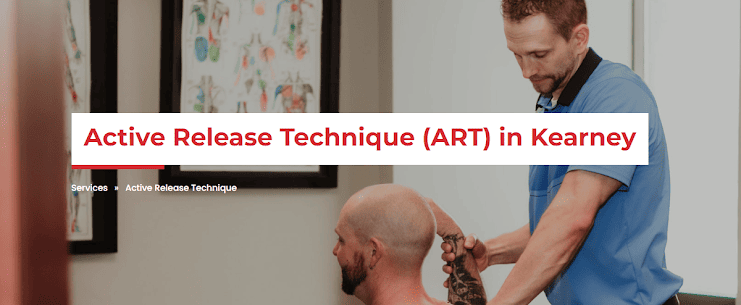
In the realm of physical therapy and rehabilitation, the Active Release Technique (ART) stands out as a beacon of hope for those suffering from soft tissue ailments. Conceived over three decades ago by Dr. P. Michael Leahy, ART has evolved from an exclusive remedy for elite athletes to a widespread therapeutic practice benefiting millions worldwide.
Understanding ART
At its core, ART is a state-of-the-art treatment that addresses the body’s soft tissues—muscles, ligaments, tendons, nerves—through a unique combination of targeted manipulation and guided movement. This technique is not just about alleviating pain; it’s about restoring the harmony of movement and function within the body.
The ART Spectrum
Body Parts: ART is versatile, capable of treating a range of body parts afflicted by discomfort or injury. It dives deep into the fascia, the fibrous tissue enveloping muscles and organs, to alleviate conditions like plantar fasciitis. It also targets major muscle groups, tendons, and ligaments, addressing strains, pulls, and injuries that hinder everyday activities.
Conditions: The scope of ART extends to a variety of conditions, from lower back pain and chronic neck discomfort to more specific ailments like carpal tunnel syndrome and tennis elbow. Its efficacy in treating these conditions has made ART a sought-after solution for those seeking relief and recovery.
The ART Mechanism
The essence of ART lies in its ability to break up adhesions—dense scar tissue formations that arise from muscle and connective tissue injuries. These adhesions can restrict movement, leading to pain, stiffness, and reduced flexibility. ART meticulously targets these areas, applying precise pressure to dismantle the scar tissue, thus restoring freedom of movement and alleviating discomfort.
Recognizing the Need for ART
How do you know if ART is right for you? Look out for signs like persistent stiffness in key areas (neck, back, elbows), increased pain during physical activity, or the sensation of tingling and numbness in your extremities. These symptoms often indicate the presence of scar tissue and the potential need for ART intervention.
ART Goals
- Dismantle Adhesions: The primary objective of ART is to break down the scar tissue adhesions that restrict movement and cause pain, restoring free motion to the soft tissues.
- Rejuvenate Soft Tissues: Beyond simply breaking up scar tissue, ART aims to rehabilitate the affected muscles, ligaments, tendons, nerves, and fascia to their optimal state, promoting faster healing and recovery.
- Alleviate Pain: By addressing the root cause of soft tissue discomfort, ART effectively reduces pain levels, making everyday movements and activities less daunting.
- Enhance Range of Motion: A significant goal of ART is to improve flexibility and mobility, allowing patients to perform physical activities with greater ease and less discomfort.
- Improve Functional Abilities: ART is designed to not just treat the symptoms but also enhance the overall functionality of the body, aiding in better performance in daily tasks and sports activities.
ART Advantages
- Increased Flexibility: One of the standout benefits of ART is its ability to enhance the elasticity of muscles and connective tissues, leading to improved flexibility.
- Expanded Range of Motion: Patients often experience a notable increase in their range of motion post-ART treatment, enabling them to move more freely and with less pain.
- Reduction in Discomfort: ART is particularly effective in diminishing pain, especially in chronic trouble areas like the lower back and neck, providing significant relief to sufferers.
- Effective Management of Specific Conditions: Conditions such as shin splints, plantar fasciitis, and sciatica, which can severely impact one’s quality of life, have been successfully managed and alleviated with ART, offering patients a holistic improvement in well-being.
- Holistic Improvement in Quality of Life: The comprehensive benefits of ART extend beyond just physical improvements, contributing to a better overall quality of life by allowing patients to engage in activities they enjoy without being hindered by pain and stiffness.
Comparing ART with Similar Therapies
While ART shares similarities with treatments like deep tissue massage and Rolfing, which also focus on the manipulation of soft tissues, it distinguishes itself through the integration of active patient movements. This dynamic aspect of ART helps in precisely identifying and treating the affected areas, setting it apart from other modalities.
Contrastingly, techniques like the Graston Technique, although similar in their goal of targeting adhesions, utilize specialized instruments for tissue mobilization, differing from ART’s hands-on, movement-oriented approach. NeuroKinetic Therapy and Dry Needling, while beneficial, follow distinct methodologies and principles, highlighting ART’s unique position in the therapeutic landscape.
What to Expect
Embarking on an ART treatment journey can be intense. The therapy involves precise, sometimes deep pressure to break up scar tissue, which can be uncomfortable. However, the discomfort is a testament to the technique’s effectiveness, often yielding results in as little as one session. It’s crucial, though, to seek treatment from certified ART providers to ensure the best outcomes.
Precautions and Considerations
ART is not a one-size-fits-all solution. It’s important to consult with a healthcare professional to determine if ART is suitable for your specific condition. Certain medical situations might require a more cautious approach or an alternative treatment method.
Final Thoughts
The Active Release Technique is more than just a treatment; it’s a pathway to restored mobility, pain relief, and an enhanced quality of life. Its unique approach to addressing soft tissue injuries and conditions has made it a valuable tool in the therapeutic arsenal.
For those grappling with the limitations imposed by soft tissue ailments, ART offers a promising avenue for recovery. By re-establishing the natural harmony of movement and reducing discomfort, ART empowers individuals to return to their favorite activities and embrace a more active, fulfilling life.
If you’re navigating the challenges of soft tissue injuries or conditions, consider exploring the potential of ART. Consult with a certified ART professional and take that crucial step towards a pain-free, more vibrant existence. Embrace the transformative power of Active Release Technique and unlock a new chapter of health and wellness.

